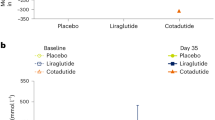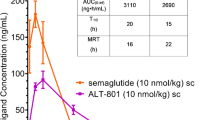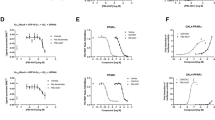Abstract
Non-alcoholic fatty liver disease and steatohepatitis are highly associated with obesity and type 2 diabetes mellitus. Cotadutide, a glucagon-like protein-1 receptor (GLP-1R) and glucagon receptor (GCGR) agonist, was shown to reduce blood glycaemia, body weight and hepatic steatosis in people with type 2 diabetes mellitus. Here, we demonstrate that the effects of cotadutide in reducing body weight and food intake and improving glucose control are predominantly mediated through Glp-1 signalling, whereas its action on the liver to reduce lipid content, drive glycogen flux and improve mitochondrial turnover and function are directly mediated through Gcg signalling. This was confirmed by the identification of phosphorylation sites on key lipogenic and glucose metabolism enzymes in liver of mice treated with cotadutide. Complementary metabolomic and transcriptomic analyses implicated lipogenic, fibrotic and inflammatory pathways, consistent with a unique therapeutic contribution of GCGR agonism by cotadutide in vivo. Notably, cotadutide also alleviated fibrosis to a greater extent than liraglutide or obeticholic acid, despite dose adjustment to achieve similar weight loss in two preclinical mouse models of NASH. Thus, cotadutide, via direct hepatic (GcgR) and extrahepatic (Glp-1R) effects, exerts multifactorial improvement in liver function and is a promising therapeutic option for the treatment of steatohepatitis.
This is a preview of subscription content, access via your institution
Access options
Access Nature and 54 other Nature Portfolio journals
Get Nature+, our best-value online-access subscription
$29.99 / 30 days
cancel any time
Subscribe to this journal
Receive 12 digital issues and online access to articles
$119.00 per year
only $9.92 per issue
Buy this article
- Purchase on Springer Link
- Instant access to full article PDF
Prices may be subject to local taxes which are calculated during checkout









Similar content being viewed by others
Data availability
The datasets generated during these studies are available from the corresponding author on reasonable request. These datasets include: in vivo data for the mouse studies and encompass metabolic, biochemical and histological data/images; mass spectrometry data from mouse liver and/or serum, mouse hepatocytes or human hepatocytes; imaging and quantitation data for mitochondrial analyses; qRT–PCR data for select gene expression analyses. RNA-seq datasets are available in the SRA database with accession number PRJNA574649.
References
Younossi, Z. et al. Global burden of NAFLD and NASH: trends, predictions, risk factors and prevention. Nat. Rev. Gastroenterol. Hepatol. 15, 11–20 (2018).
Ibrahim, S. H., Hirsova, P. & Gores, G. J. Non-alcoholic steatohepatitis pathogenesis: sublethal hepatocyte injury as a driver of liver inflammation. Gut 67, 963–972 (2018).
Friedman, S. L., Neuschwander-Tetri, B. A., Rinella, M. & Sanyal, A. J. Mechanisms of NAFLD development and therapeutic strategies. Nat. Med. 24, 908–922 (2018).
Cusi, K. Treatment of patients with type 2 diabetes and non-alcoholic fatty liver disease: current approaches and future directions. Diabetologia 59, 1112–1120 (2016).
Bueter, M. & le Roux, C. W. Gastrointestinal hormones, energy balance and bariatric surgery. Int. J. Obes. 35(Suppl. 3), S35–S393 (2011).
Ionut, V., Burch, M., Youdim, A. & Bergman, R. N. Gastrointestinal hormones and bariatric surgery-induced weight loss. Obesity 21, 1093–1103 (2013).
Meek, C. L., Lewis, H. B., Reimann, F., Gribble, F. M. & Park, A. J. The effect of bariatric surgery on gastrointestinal and pancreatic peptide hormones. Peptides 77, 28–37 (2016).
Cohen, M. A. et al. Oxyntomodulin suppresses appetite and reduces food intake in humans. J. Clin. Endocrinol. Metab. 88, 4696–4701 (2003).
Wynne, K. et al. Oxyntomodulin increases energy expenditure in addition to decreasing energy intake in overweight and obese humans: a randomised controlled trial. Int. J. Obes. 30, 1729–1736 (2006).
Scott, R., Minnion, J., Tan, T. & Bloom, S. R. Oxyntomodulin analogue increases energy expenditure via the Gcg receptor. Peptides 104, 70–77 (2018).
Ambery, P. et al. Cotadutide, a GLP-1 and Gcg receptor dual agonist, in obese or overweight patients with type 2 diabetes: a randomised, controlled, double-blind, ascending dose and phase 2a study. Lancet 10140, 2607–2618 (2018).
Day, J. W. et al. A new Gcg and GLP-1 co-agonist eliminates obesity in rodents. Nat. Chem. Biol. 5, 749–757 (2009).
Henderson, S. J. et al. Robust anti-obesity and metabolic effects of a dual GLP-1/Gcg receptor peptide agonist in rodents and non-human primates. Diabetes Obes. Metab. 18, 1176–1190 (2016).
Khajavi, N., Biebermann, H., Tschop, M. & DiMarchi, R. Treatment of diabetes and obesity by rationally designed peptide agonists functioning at multiple metabolic receptors. Endocr. Dev. 32, 165–182 (2017).
Tan, T. M. et al. Coadministration of Gcg-like peptide-1 during Gcg infusion in humans results in increased energy expenditure and amelioration of hyperglycemia. Diabetes 62, 1131–1138 (2013).
Pocai, A. et al. Glucagon-like peptide 1/Gcg receptor dual agonism reverses obesity in mice. Diabetes 58, 2258–2266 (2009).
Patel, V. et al. Coagonist of GLP-1 and Gcg receptor ameliorates development of non-alcoholic fatty liver disease. Cardiovasc. Hematol. Agents Med. Chem. 16, 35–43 (2018).
Patel, V. et al. Coagonist of Gcg-like peptide-1 and Gcg receptors ameliorates nonalcoholic fatty liver disease. Can. J. Physiol. Pharmacol. 96, 587–596 (2018).
Valdecantos, M. P. et al. A novel Gcg-like peptide 1/Gcg receptor dual agonist improves steatohepatitis and liver regeneration in mice. Hepatology 65, 950–968 (2017).
Hansen, H. H. et al. Mouse models of nonalcoholic steatohepatitis in preclinical drug development. Drug Discov. Today 22, 1707–1718 (2017).
Koliaki, C. et al. Adaptation of hepatic mitochondrial function in humans with non-alcoholic fatty liver is lost in steatohepatitis. Cell Metab. 21, 739–746 (2015).
Boland, M. L. et al. Nonalcoholic steatohepatitis severity is defined by a failure in compensatory antioxidant capacity in the setting of mitochondrial dysfunction. World J. Gastroenterol. 24, 1748–1765 (2018).
Shaw, R. J. et al. The kinase LKB1 mediates glucose homeostasis in liver and therapeutic effects of metformin. Science 310, 1642–1646 (2005).
Lawitz, E. J. et al. Acetyl-CoA carboxylase inhibitor GS-0976 for 12 weeks reduces hepatic de novo lipogenesis and steatosis in patients with nonalcoholic steatohepatitis. Clin. Gastroenterol. Hepatol. 16, 1983–1991 (2018).
Koo, S.-H. et al. The CREB coactivator TORC2 is a key regulator of fasting glucose metabolism. Nature 437, 1109–1113 (2005).
Dulai, P. S. et al. Increased risk of mortality by fibrosis stage in nonalcoholic fatty liver disease: systematic review and meta-analysis. Hepatology 65, 1557–1565 (2017).
Armstrong, M. J. et al. Liraglutide safety and efficacy in patients with non-alcoholic steatohepatitis (LEAN): a multicentre, double-blind, randomised, placebo-controlled phase 2 study. Lancet 387, 679–690 (2016).
Loomba, R. et al. GS-0976 reduces hepatic steatosis and fibrosis markers in patients with nonalcoholic fatty liver disease. Gastroenterology 155, 1463–1473 (2018).
Neuschwander-Tetri, B. A. et al. Farnesoid X nuclear receptor ligand obeticholic acid for non-cirrhotic, non-alcoholic steatohepatitis (FLINT): a multicentre, randomised, placebo-controlled trial. Lancet 385, 956–965 (2015).
Ayala, J. E. et al. Hyperinsulinemic–euglycemic clamps in conscious, unrestrained mice. J. Vis. Exp. e3188 (2011).
Steele, R., Wall, J. S., De Bodo, R. C. & Altszuler, N. Measurement of size and turnover rate of body glucose pool by the isotope dilution method. Am. J. Physiol. 187, 15–24 (1956).
Bederman, I. R., Foy, S., Chandramouli, V., Alexander, J. C. & Previs, S. F. Triglyceride synthesis in epididymal adipose tissue: contribution of glucose and non-glucose carbon sources. J. Biol. Chem. 284, 6101–6108 (2009).
Hasenour, C. M. et al. Mass spectrometry-based microassay of 2H and 13C plasma glucose labeling to quantify liver metabolic fluxes in vivo. Am. J. Physiol. Endocrinol. Metab. 309, E191–E203 (2015).
Young, J. D. INCA: a computational platform for isotopically non-stationary metabolic flux analysis. Bioinformatics 30, 1333–1335 (2014).
Hughey, C. C. et al. Loss of hepatic AMP-activated protein kinase impedes the rate of glycogenolysis but not gluconeogenic fluxes in exercising mice. J. Biol. Chem. 292, 20125–20140 (2017).
Chan, T. M. & Exton, J. H. A method for the determination of glycogen content and radioactivity in small quantities of tissues or isolated hepatocytes. Anal. Biochem. 71, 96–105 (1976).
Yang, D. et al. Assay of low deuterium enrichment of water by isotopic exchange with [U-13C3]acetone and gas chromatography-mass spectrometry. Anal. Biochem. 258, 315–321 (1998).
Previs, S. F. et al. Using [2H]water to quantify the contribution of de novo palmitate synthesis in plasma: enabling back-to-back studies. Am. J. Physiol. Endocrinol. Metab. 315, E63–e71 (2018).
Burgess, S. C. et al. Impaired tricarboxylic acid cycle activity in mouse livers lacking cytosolic phosphoenolpyruvate carboxykinase. J. Biol. Chem. 279, 48941–48949 (2004).
Antoniewicz, M. R., Kelleher, J. K. & Stephanopoulos, G. Measuring deuterium enrichment of glucose hydrogen atoms by gas chromatography/mass spectrometry. Anal. Chem. 83, 3211–3216 (2011).
Kristiansen, M. N. et al. Obese diet-induced mouse models of nonalcoholic steatohepatitis-tracking disease by liver biopsy. World J. Hepatol. 8, 673–684 (2016).
Barascuk, N. et al. A novel assay for extracellular matrix remodeling associated with liver fibrosis: an enzyme-linked immunosorbent assay (ELISA) for a MMP-9 proteolytically revealed neo-epitope of type III collagen. Clin. Biochem. 43, 899–904 (2010).
Leeming, D. J. et al. Enzyme-linked immunosorbent serum assay specific for the 7S domain of Collagen Type IV (P4NP 7S): a marker related to the extracellular matrix remodeling during liver fibrogenesis. Hepatol. Res. 42, 482–493 (2012).
Vassiliadis, E. et al. Immunological detection of the type V collagen propeptide fragment, PVCP-1230, in connective tissue remodeling associated with liver fibrosis. Biomarkers 16, 426–433 (2011).
Ouberai, M. M. et al. Controlling the bioactivity of a peptide hormone in vivo by reversible self-assembly. Nat. Commun. 8, 1026 (2017).
Kleiner, D. E. et al. Design and validation of a histological scoring system for nonalcoholic fatty liver disease. Hepatology 41, 1313–1321 (2005).
Glick, D. et al. BNip3 regulates mitochondrial function and lipid metabolism in the liver. Mol. Cell Biol. 32, 2570–2584 (2012).
Michopoulos, F. et al. Targeted profiling of polar intracellular metabolites using ion-pair-high performance liquid chromatography and -ultra high performance liquid chromatography coupled to tandem mass spectrometry: applications to serum, urine and tissue extracts. J. Chromatogr. A. 1349, 60–68 (2014).
Dobin, A. et al. STAR: ultrafast universal RNA-seq aligner. Bioinformatics 29, 15–21 (2013).
Subramanian, A. et al. Gene set enrichment analysis: a knowledge-based approach for interpreting genome-wide expression profiles. Proc. Natl Acad. Sci. USA 102, 15545–15550 (2005).
Liberzon, A. et al. Molecular signatures database (MSigDB) 3.0. Bioinformatics 27, 1739–1740 (2011).
Liberzon, A. et al. The Molecular Signatures Database (MSigDB) hallmark gene set collection. Cell Syst. 1, 417–425 (2015).
Hanzelmann, S., Castelo, R. & Guinney, J. GSVA: gene set variation analysis for microarray and RNA-seq data. BMC Bioinformatics 14, 7 (2013).
Kang, T. et al. Characterization of the molecular mechanisms underlying glucose stimulated insulin secretion from isolated pancreatic beta-cells using post-translational modification specific proteomics (PTMomics). Mol. Cell Proteomics 17, 95–110 (2018).
The, N. et al. Fast and accurate proteim false discovery rates on large-scale proteomics data sets with percolator 3.0. J. Am. Soc. Mass Spectrom. 27, 1719–1727 (2016).
Käll, L. et al. Semi-supervised learning for peptide identification from shotgun proteomics datasets. Nat. Methods 4, 923–925 (2007).
Marx, H. et al. A large synthetic peptide and phosphopeptide reference library for mass spectrometry-based proteomics. Nat. Biotechnol. 13, 557–566 (2013).
Navarro, P. et al. General statistical framework for quantitative proteomics by stabe isotope labeling. J. Proteome Res. 13, 1234–1247 (2014).
Zierer, J. et al. The fecal metabolome as a functional readout of the gut microbiome. Nat. Genet. 50, 790–795 (2018).
Zhang, M. et al. Adipocyte-derived lipids mediate melanoma progression via FATP proteins. Cancer Discov. 8, 1006–1025 (2018).
Lofgren, L. et al. The BUME method: a novel automated chloroform-free 96-well total lipid extraction method for blood plasma. J. Lipid. Res. 53, 1690–1700 (2012).
Acknowledgements
The authors wish to thank the Lab Animal Resource staff at MedImmune/AstraZeneca for their assistance with animal husbandry and care. We thank D. Leeming and M. Karsdal (Nordic Biosciences, Denmark) for assistance with circulating collagen fragment detection and interpretation. We thank K. Hightower (Metabolon, Durham, NC) for assistance with metabolomics analyses and interpretation. The authors also wish to thank M. Jain (AstraZeneca, Cambridge, UK) for critical review and comments on the manuscript during preparation. The Villum Center for Bioanalytical Sciences at University of Southern Denmark is acknowledged for access to high-end MS instruments. Vanderbilt MMPC and their NIH funding (DK059637).
Author information
Authors and Affiliations
Contributions
M.L.B., R.C.L., A.N., M.F., M.R.L., L.L., O.P.M. and J.L.T. designed experiments; M.L.B., R.C.L., A.N., S.O., B.B.B., H.L., J.C., K.M., J.N., M.F., M.R.L., L.L., O.P.M., C.J.R. and J.L.T. collected and/or analysed and interpreted experimental data; S.G. and S.S.V. provided pathology analysis of mouse NASH studies; M.L.B, R.C.L., J.G., M.R.L, C.J.R. and J.L.T. wrote the paper; C.M.R. and L.J. reviewed and edited the manuscript.
Corresponding author
Ethics declarations
Competing interests
The authors declare competing interests as defined by Nature Research. Employee of AstraZeneca (R.C.L., K.M., S.O., J.C., J.N., J.G., L.J., C.J.R.). Owns stock in AstraZeneca (K.M., S.O., J.C., J.N., J.G., L.J., C.M.R., J.L.T., C.J.R.).
Additional information
Publisher’s note Springer Nature remains neutral with regard to jurisdictional claims in published maps and institutional affiliations.
Extended data
Extended Data Fig. 1 Metabolic and hepatic parameters following six-week treatment of NASH C57Bl6/J mice.
Mice were treated with cotadutide, liraglutide, g1437 or liraglutide+g1437 at equimolar dosing (10 nmol/kg, SC, QD for 42 days) compared to vehicle. Animals were given ad libitum access to food for the entirety of the study except on day 14 mice were fasted for 6 h prior to ipPTT. a, Reduction in body weight throughout the 42-day dosing period shown as % change. b, Blood glucose profile during ipPTT (pyruvate given at dose of 2g/kg) and (c) area under the ipPTT curve. d, Fasting plasma insulin, (e) fasting blood glucose and (f) plasma ALT levels at the end of the study. g, Terminal liver glycogen content, (h) triglycerides and (i) cholesterol. Chow vehicle (n=10); NASH vehicle (n=11); Cotadutide (n=12); Liraglutide (n=12); g1437 (n=12); Liraglutide+g1437 (n=12). Data shown as the mean ± SEM. (a and b) Two-way ANOVA, Tukey’s multiple comparisons post-hoc test. In (a and b) colored lines and p-values indicated differences for the corresponding treatment group compared with NASH vehicle at each time point. c-i, Two-sided student’s t-test for chow controls vs. NASH vehicle to determine effect of NASH diet; One-way ANOVA, Tukey’s multiple comparisons post-hoc test, chow group excluded.
Extended Data Fig. 2 Table of phosphopeptides.
Description of hepatic phosphopeptides detected in primary mouse and human hepatocytes following treatment with g1437.
Extended Data Fig. 3 Table of phosphopeptides.
Description of hepatic phosphopeptides detected in primary mouse and human hepatocytes following treatment with g1437.
Extended Data Fig. 4 Cotadutide improves mitochondrial respiratory function in primary mouse hepatocytes through Gcg signaling mechanisms.
a, Mitochondrial oxygen consumption rate (OCR) during mitochondrial stress test of healthy primary murine hepatocytes treated ex vivo for 4h with 100 nM cotadutide, g1437 or liraglutide compared to vehicle control hepatocytes (n=3 biologically independent samples/group). b, Basal respiration and (c) maximal respiration measured following injection of uncoupler FCCP. d, Oxygen consumption of primary mouse hepatocytes shown as the percentage of total respiration that is driven by the oxidation of indicated substrates (n=2 biologically independent samples/group). e-i, Oxygen consumption of mouse primary hepatocytes, during mitochondrial stress test, treated with cotadutide +/- Ampk inhibitor, Compound C (e; 20 uM), p38Mapk inhibitor, SB203580 (f; 20 um), mTor inhibitor, Rapamycin (g; 1 uM), Pi3 inhibitor, LY294 (h; 10 uM) or Mapkk inhibitor, PD98 (i; 20 uM) compared with control treated hepatocytes. n=6 replicates from 1 biological samples for all except for Cotadutide; Cotadutide+SB203580; Rapamycin; Cotadutide+Rapamycin; PD98; Cotadutide+PD98 in which 5 replicates were performed. The experiment was performed on 3 separate occasions with similar results. All data shown as the mean ± SEM. b-d, One-way ANOVA with Dunnett’s multiple comparisons post-hoc test.
Extended Data Fig. 5 Cotadutide reduces hepatic fibrosis and inflammation corresponding to animals shown in Figs. 7 and 8.
a, representative αSma stained liver sections, quantification is provided in Fig. 8d. Scale bar = 100 µm. b, representative PSR stained liver sections, quantification is provided in Fig. 8e. Scale bar = 100 µm. These experiments were performed in ob/ob mice with LFD (n=8); AMLN vehicle (n=11); Cotadutide (n=7); Liraglutide (n= 10); AMLN-to-LFD (n=10) mice/group.
Extended Data Fig. 6 Grades of histopathological NASH features corresponding to animals in Figs. 7 and 8.
a, steatosis grade, (b) lobular inflammation, (c) biliary hyperplasia and (d) hepatocyte ballooning. LFD (n=8); Vehicle (n=11); Cotadutide (n=7); Liraglutide (n=10); AMLN-to-LFD (n=10). Data represented as the mean ± SEM. Two-sided student’s t-test for LFD vs. vehicle to determine effect of NASH diet; one-way ANOVA, Tukey’s multiple comparison post-hoc test, LFD group excluded.
Extended Data Fig. 7 CD68, a marker of immune cell infiltration, is reduced by Cotadutide in animals corresponding to Figs. 7 and 8.
a, Representative images of CD68 IHC staining of mouse liver and the (b) pathologist graded scoring. LFD control slides are set to baseline of 1 to account for resident Kupffer cells (dark stained spots disperse equally between hepatocytes). Infiltration of immune cells identified by accumulation around vacuoles we scored relative to the baseline. Scale bar = 200 µm. LFD (n=8); Vehicle (n=11); Cotadutide (n=7); Liraglutide (n=10); AMLN-to-LFD (n=10). Data represented as the mean ± SEM. Two-sided student’s t-test for LFD vs. vehicle to determine effect of NASH diet; One-way ANOVA, Tukey’s multiple comparisons post-hoc test, LFD group excluded.
Supplementary information
Supplementary Information
Supplementary Figures 1–13, Tables 1–10 and References
Rights and permissions
About this article
Cite this article
Boland, M.L., Laker, R.C., Mather, K. et al. Resolution of NASH and hepatic fibrosis by the GLP-1R and GCGR dual-agonist cotadutide via modulating mitochondrial function and lipogenesis. Nat Metab 2, 413–431 (2020). https://doi.org/10.1038/s42255-020-0209-6
Received:
Accepted:
Published:
Issue Date:
DOI: https://doi.org/10.1038/s42255-020-0209-6
This article is cited by
-
Cryo-electron microscopy for GPCR research and drug discovery in endocrinology and metabolism
Nature Reviews Endocrinology (2024)
-
Dose–response effects on HbA1c and bodyweight reduction of survodutide, a dual glucagon/GLP-1 receptor agonist, compared with placebo and open-label semaglutide in people with type 2 diabetes: a randomised clinical trial
Diabetologia (2024)
-
Animal studies on glucagon-like peptide-1 receptor agonists and related polyagonists in nonalcoholic fatty liver disease
Hormones (2024)
-
Advances in basic research on glucagon and alpha cells
Diabetology International (2024)
-
Remodeling the hepatic fibrotic microenvironment with emerging nanotherapeutics: a comprehensive review
Journal of Nanobiotechnology (2023)



